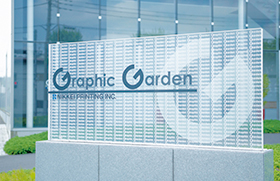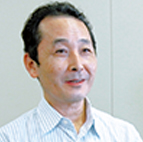- Home
- Horizon Spotlight
- Nikkei Printing Inc.
Horizon Spotlight
Labor Saving. Intuitive Operation. Professional Quality.
StitchLiner MarkⅢ
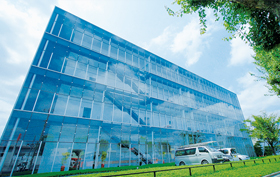
Nikkei Printing Inc. was founded on Opening Day of the 1964 Tokyo Olympics. The company soon gained a reputation for quick-turnaround times and high-quality fi nished products. Today, their main customers include publishing houses, schools, tutoring companies, and government agencies. Thanks to their continued focus on speed and quality, the company has a 40% share of their respective market.
Managing Director Tetsuji Kubota’s goal is to maintain “The fast-est turnaround time in Tokyo”. To keep that competitive advantage, the company operates out of two facilities close to their Tokyo clien-tele. The fi rst was completed in 1997 and brought fi nishing capabil-ities in-house to reduce turnaround times and save on outsourcing. The second, larger Graphic Garden facility was completed in 2008 and is now the main production site.
It wasn’t until 2001 that Nikkei decided to expand into the color printing market and installed their fi rst 8-color press. The new color capabilities allowed them to create photo albums and textbooks, but also created a demand for pamphlets, brochures and other sad-dle-stitched products.
By the time the Graphic Garden facility opened, saddle-stitched books made up 50% of the work Nikkei produced. To keep up with demand, the company originally installed six traditional sad-dle-stitchers that use folded signatures. However, it soon became clear that two machines handled 80% of jobs while the remaining four machines struggled to handle remaining short-run, thin book orders. The traditional stitchers excelled at long runs, but were not designed to meet the changing needs of the marketplace.
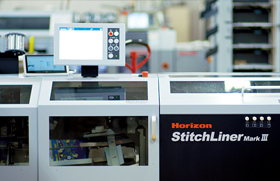
The turning point came during a trip to a partner company’s facility. On the production floor Mr. Kubota, watched as a single inexperienced operator was able to set up and begin production on a Horizon saddle stitcher without any assistance. This led him to believe that Horizon could be the solution to solving his production troubles. Soon after, a Horizon StitchLiner 5500 was installed at Nikkei and took on the traditionally time consuming short-run, thin book production.
The new Stitchliner greatly reduced the changeovers times com-pared to the traditional saddle-stitchers and led to an increase in overall productivity. In 2008, Nikkei rea ffi rmed their trust to Hori-zon solutions with the addition of a StitchLiner Mark III. Now, the saddle-stitching department at Nikkei Printing produces 1.3 million books per month and relies heavily on their Horizon StitchLiner Mark III and StitchLiner 5500 systems. While both machines see heavy production daily, only a single operator is required per ma-chine which helps keep labor costs low.
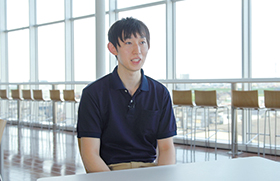 Saddle Stitcher Operator Toshiya Soma
Saddle Stitcher Operator Toshiya Soma
When making the decision on whether to invest in a new piece of technology, Nikkei prioritizes solutions that take the guesswork out of production, require as little training as possible, and streamline production.
“A machine has to help us turn a profit.” Mr. Yamamoto says, “With the StitchLiners, the profi t per operator is extremely high. The U-shaped confi guration cuts down on labor costs by allowing just a single operator to run the whole system. The low labor costs and high output make it a money maker.”
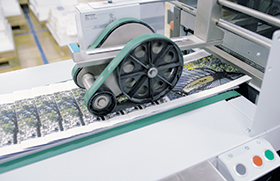
To oversee production on their StitchLiner 5500 and StitchLiner Mark III, Nikkei employs only a single operator for each system. In comparison, their traditional saddle stitchers require a skilled lead operator and two to three additional support staff to guarantee smooth production. Their perfect bound line needs a minimum of four operators, but that can increase to as many as ten during peak production.
Experience is not an issue when it comes to running the Stitch-Liner either. At Nikkei, they were able to place a new hire in charge of the machine from the start. In half a day they were able to learn the basics and spent the remainder of the week training on advanced features while continuing production.
Thanks to the automated setup and simple operation of the Stitch-Liner series, even inexperienced operators are able to quickly master the solution. “The automation and operator friendly interface lets us start producing jobs right away.” Remarked Mr. Yamamoto, “You just need to enter a few numbers and the machine takes care of the rest automatically. Other manufacturers advertise automation, but in reality most are really complicated to set up and run.”
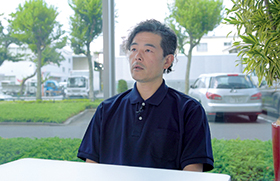 Production Manager Yuji Yamamoto
Production Manager Yuji Yamamoto
The Stitchliner has solidifi ed Nikkei’s speed advantage. A short-run 24 page job can be received in the morning and be shipped out the same day.
“We have a strict schedule to follow.” Stresses Mr. Kubota, “Even if we have five rush jobs thrown into the mix, our customers are counting on us to make their deadlines.” That di ffi cult task belongs to the production division which needs to be sure their machines can handle whatever the day brings. A normal day usually consists of nine to ten diff erent jobs being produced on the StitchLiner. How-ever, that number can reach as high as thirty-six jobs in a single day when working with short runs of 20 books.
Mr. Kubota says the ability to efficiently handle short runs is thanks to the quick, automated set up times. “While text book orders as a whole are slowly decreasing, the variety of jobs is increasing. We have to produce short to medium runs across subjects and school levels. With a traditional saddle-stitcher we would fi rst need to fold the signatures and then take the time to do changeovers between jobs. With the Horizon machine, we can simply cut the sheets on a guillotine, bring them to the collator and press start. That’s a huge advantage. The short changeover times were the biggest factor in the decision to choose Horizon.” The shortened turned around times are credited with increasing customer satisfaction and creating new business opportunities.
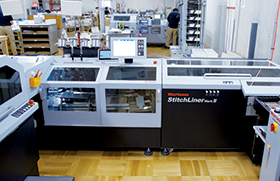
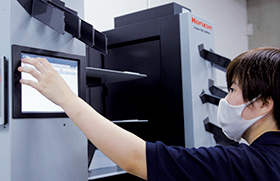
Nikkei has taken the step of independently developing a software solution called “Print Station’’ to manage their production workfl ow. The software has increased the company’s operation e ffi ciency by collecting job info, displaying job status, and tracking output from every step in the production process. By linking with and sending job info directly to Horizon’s pXnet system, the system eliminates the need to manually input data at the fi nishing device. Machine sta-tus and production results can then be sent back to Print Station to manage and analyze the entire workfl ow.
“With the Stitchliner there’s barely any operator input during set-up. When working with a traditional saddle-stitcher I have to follow a complicated operation manual just to input all the necessary info for a job to begin. On the Horizon machines, I can complete a job changeover in just fi ve minutes. When the number of jobs increases, those fi ve minutes make all the diff erence.” said operator Soma.
“When an operator has to manually input job info, mistakes will be made.” Mr. Yamamoto is quick to point out, “By generating barcodes with our software we’re able to automate the process and eliminate operator error. The ability to track job status lets us quick-ly recognize when an issue occurs and begin the recovery process right away.”
Thinking about continued optimization, he sees automation playing a key role, “Standardization of jobs allows us to integrate automated technology into production. That production is then monitored and controlled by our management software. This smart workfl ow is essential to our continued success.”Thanks to the com-patibility of pXnet and cloud based Print Station, StitchLiner ma-chine status and job progress can be accessed on any device with an internet connection.
“The StitchLiner is able to match the finishing quality of our traditional saddle-stitchers” says Mr. Yamamoto. “Actually, I think the page to page registration quality is higher on the StitchLiner since the signatures don’t need to be folded.” Adds operator Soma. The barcode verifi cation feature helps prevent missing and out of order pages. “When producing large quantities of short run jobs in a single day, someone will eventually misplace a stack of signatures. Our operators can’t tell in a tell apart an introductory English level textbook page from an intermediate level page in a single glance. The verifi cation systems are essential for our high-priority jobs.”
How to handle the peaks and valleys of production is the next problem Nikkei is looking to solve. Some machines see heavy use during peak periods and then remain idle during the rest of the year. However, operator-friendly and reliable machines like the Stitch-Liner provide a solution. Mr. Yamamoto says, “Job standardization and automation help us reduce labor costs by eliminating the need for specialized operators. Instead, we can focus on training people to work on a wide variety of equipment.”
Mr. Yamamoto is looking forward to working with Horizon to add another level of quality control to their production lines, “Our daily schedule is getting tighter and tighter, but we still have the pressure to deliver fi nished products to customers the next day. During peak times machine failure can be a disaster. We perform regular mainte-nance on the machines to keep them running smoothly and prevent issues that could affect quality or turnaround times. Moving for-ward, we’d like to share our maintenance data with Horizon to keep track of part wear and tear and catch any potential problems before they even occur.”
